Physical Address
304 North Cardinal St.
Dorchester Center, MA 02124
colitis-associated neoplasia Crohn’s disease confocal laser endomicroscopy dye chromoendoscopy endoscopy-based confocal laser endomicroscopy gastrointestinal high-definition inflammatory bowel disease image-enhanced endoscopy magnification endoscopy mucosal healing narrow-band imaging optical coherence tomographyp confocal laser endomicroscopy primary sclerosing cholangitisTNF tumor necrosis factor ulcerative colitis white-light endoscopy CAN
CD
CLE
DCE
eCLE
GI
HD
IBD
IEE
ME
MH
NBI
OCT
CLE
PSC
UC
WLE
Advances in imaging technology have made in vivo endoscopic inspection of mucosal and submucosal microstructures possible, to the level of spatial resolution and depth beyond standard white-light endoscopy (WLE). The image-enhanced endoscopy (IEE) includes confocal laser endomicroscopy (CLE), endocytoscopy, magnification endoscopy (ME), optical coherence tomography (OCT), and ultrasound elastography. The current main applications of these IEE techniques in inflammatory bowel disease (IBD) are the assessment of disease activity, surveillance of colitis-associated neoplasia (CAN), and transmural disease process. Accurate measurement of disease activity in IBD is imperative for the treatment and prognosis. In addition to clinical, laboratory, and radiographic evaluation, most clinicians prefer direct visualization of disease activity. Mucosal healing (MH) has been set as one of the primary targets for medical therapy. While the criteria and application of histologic MH are evolving, WLE-based endoscopic MH is increasingly used in clinical trials and clinical practice. However, deep tissue healing consists of clinical, endoscopic, histologic, and biological aspects; and from mucosal to transmural. IEE positions well in between WLE and histology. In contrast to tedious and invasive tissue sampling in histologic evaluation, IEE such as CLE and endocytoscopy can provide in vivo virtual ultramagnification images as well as the areas for targeted biopsy. Furthermore, high-resolution imaging makes surveillance of CAN more accurate.
Dye-based chromoendoscopy and virtual chromoendoscopy are discussed in Chapter 19 , Chromoendoscopy in inflammatory bowel disease.
CLE is a novel endoscopic imaging modality that allows real-time visualization of subcellular architecture details of the gastrointestinal (GI) tract. This imaging technique is designed to provide noninvasive, 3D optical biopsies of the luminal surface allowing instantaneous virtual histologic diagnosis. CLE delivers an excitation wavelength of 488 nm and confocal image data are collected at different scan rates depending on the system used. Confocal images can be collected simultaneously with endoscopic images. It can be performed using a probe-based system (probe-based confocal laser endomicroscopy by Cellvizio, Mauna Kea Technologies, Paris, France) passed through the channel of a standard endoscope or with a miniaturized confocal microscope integrated into the distal tip of an endoscope [endoscopy-based confocal laser endomicroscopy (eCLE) by Pentax, Fort Wayne, NJ]. Both the systems are approved by the Food and Drug Administration of the United States; currently, the probe-based confocal laser endomicroscopy (pCLE) is the only modality in clinical use as eCLE is no longer commercially available ( Fig. 20.1 ).
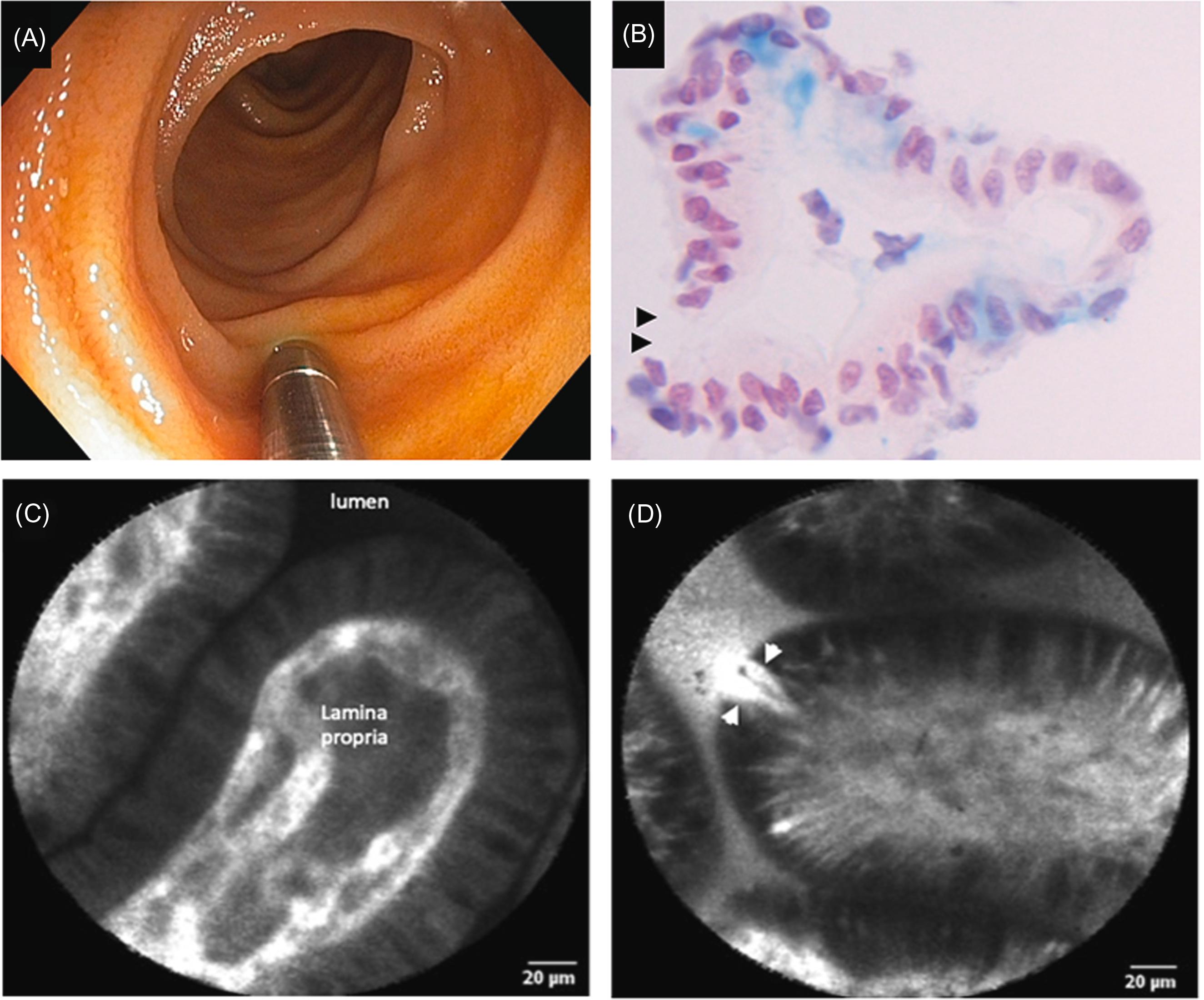
To illuminate tissue structures, CLE is performed with the aid of contrast agents such as intravenous fluorescein (2.5 or 5 mL of 10% solution) or topical contrast agents, including acriflavine hydrochloride and cresyl violet (both not available in the United States). The CLE scope is gently placed on the mucosal surface and scans the area to create an optical biopsy of the tissue in the horizontal plane. In the eCLE system, a scan of different depths can be performed to generate a collection of images termed z-stacks.
Common clinical indications for CLE include surveillance of dysplasia in Barrett’s esophagus and identification and characterization of colorectal polyps. In patients with IBD, CLE has been used for both structural and functional assessment of the intestinal epithelium. Specifically, CLE was used to evaluate the severity of intestinal inflammation in the diagnosis of IBD, and mucosal barrier functional status to determine the probability of disease relapse and guide the selection of biological therapy. Here, we will highlight the role of CLE and in vivo imaging in advancing our understanding of the pathophysiology of IBD, thereby improving the clinical management of patients.
The ability to accurately gauge the severity of mucosal inflammation and detect microscopic inflammation in IBD is highly relevant in the care of patients as endoscopic MH has emerged as an important goal of therapy. MH is associated with more favorable clinical outcomes, including decreased disease activity, reduced rate of hospitalization or surgical resections, and increased rate of sustained clinical remission . However, conventional WLE is not a modality with adequate sensitivity to assess mucosal inflammation; therefore the gold standard remains histopathological assessment of intestinal biopsy samples.
CLE provides a real-time evaluation of mucosal inflammation and can detect microscopic inflammation in areas with a normal macroscopic appearance. When examined by CLE, inflamed mucosa in IBD patients has multiple abnormalities, including irregular and tortuous crypts with irregular and wider lumens in addition to fluorescein leakage into the interstitial space . CLE has been used to develop classification systems for inflammatory activity in patients with ulcerative colitis (UC). Kiesslich et al. reported a three-grade classification system for inflammation consisting of classification of crypt architecture, microvascular alterations, and cellular infiltration ( Table 20.1 ; Figs. 20.1 and 20.2 ). Crypt architecture was defined using another CLE-based system by Li et al. ( Table 20.2 ; Figs. 20.3–20.6 ). Fluorescein leakage was shown to have a significant correlation with histologic findings in UC patients, with more than half of the patients with normal-appearing mucosa on conventional WLE revealed acute inflammation on histopathology . Another study prospectively demonstrated that a composite score based on fluorescein leakage and crypt diameter was predictive of disease flare in UCin a 12-month follow-up . In Crohn’s disease (CD), another system to grade inflammatory activity known as the CD Endomicroscopic Activity Score has been proposed to differentiate active versus quiescent disease and includes parameters such as crypt number, colonic crypt distortion, and microerosions, augmented vascularization, quantification of goblet cells, and increased cellular infiltration . Overall, CLE appears to be a sensitive tool to instantly assess inflammatory activity in IBD patients and reliably detect microscopic inflammation in macroscopically noninflamed mucosa.
| Grade of inflammation | Crypt architecture | Cellular infiltration | Vascular architecture |
|---|---|---|---|
| None | Regular luminal openings and distribution of crypts covered by a homogeneous layer of epithelial cells, including goblet cells | Absent | Normal hexagonal, honeycomb appearance that presents a network of capillaries outlining the stroma surrounding the luminal openings of the crypts |
| Mild to moderate | Differences in shape, size, and distribution of crypts; increased distance between crypts, focal crypt destruction | Present; <50% of crypts involved | Mild to moderate increase of capillaries, dilated, and distorted capillaries |
| Severe | Unequivocal crypt destruction | Present; >50% of crypts involved | Marked increase of dilated and distorted capillaries; leakage of fluorescein |

| Crypt architecture on confocal laser endomicroscopy | Description |
|---|---|
| A | Regular arrangement and size of crypts |
| B | Irregular arrangements of crypts, enlarged spaces between crypts |
| C | Dilation of crypt openings, more irregular arrangement of crypts, and enlarged spaces between crypts as compared to type B |
| D | Crypt destruction and/or crypt abscess |
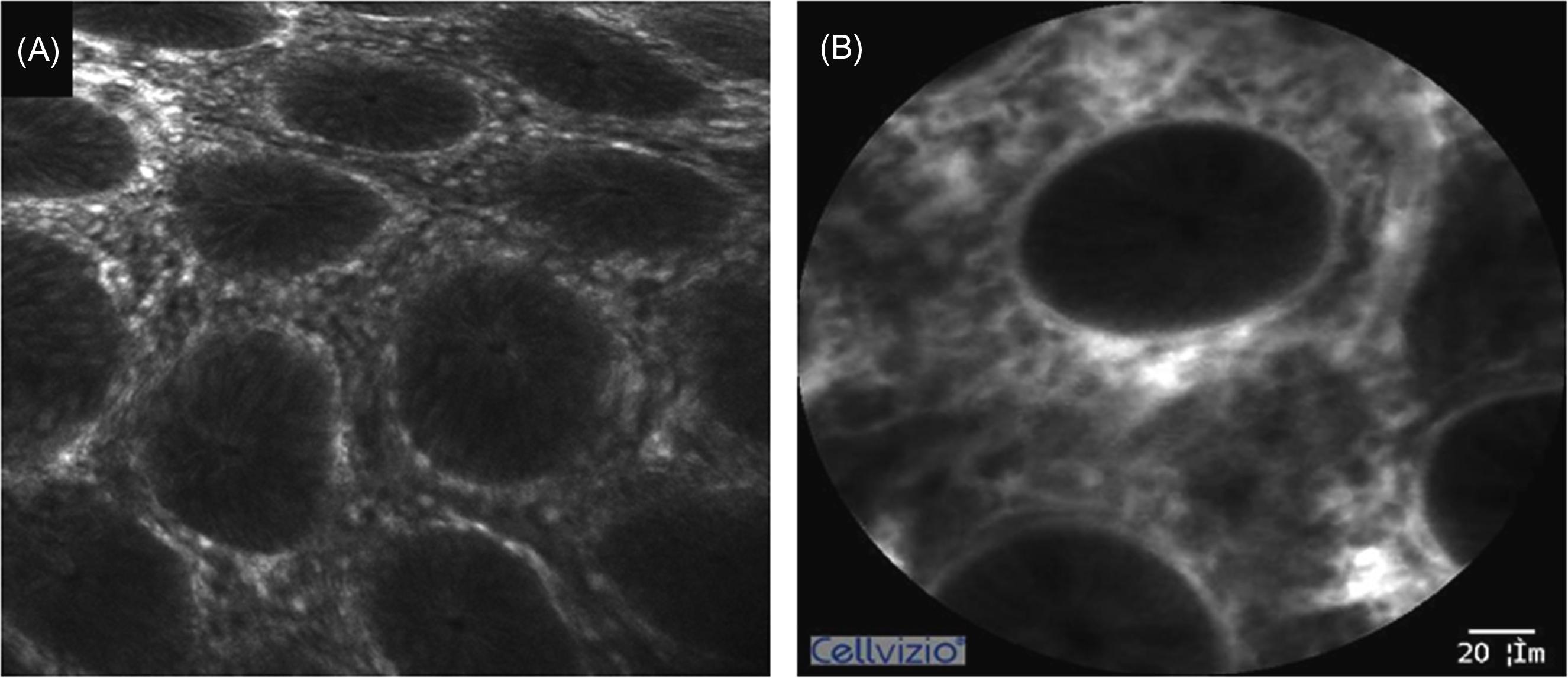
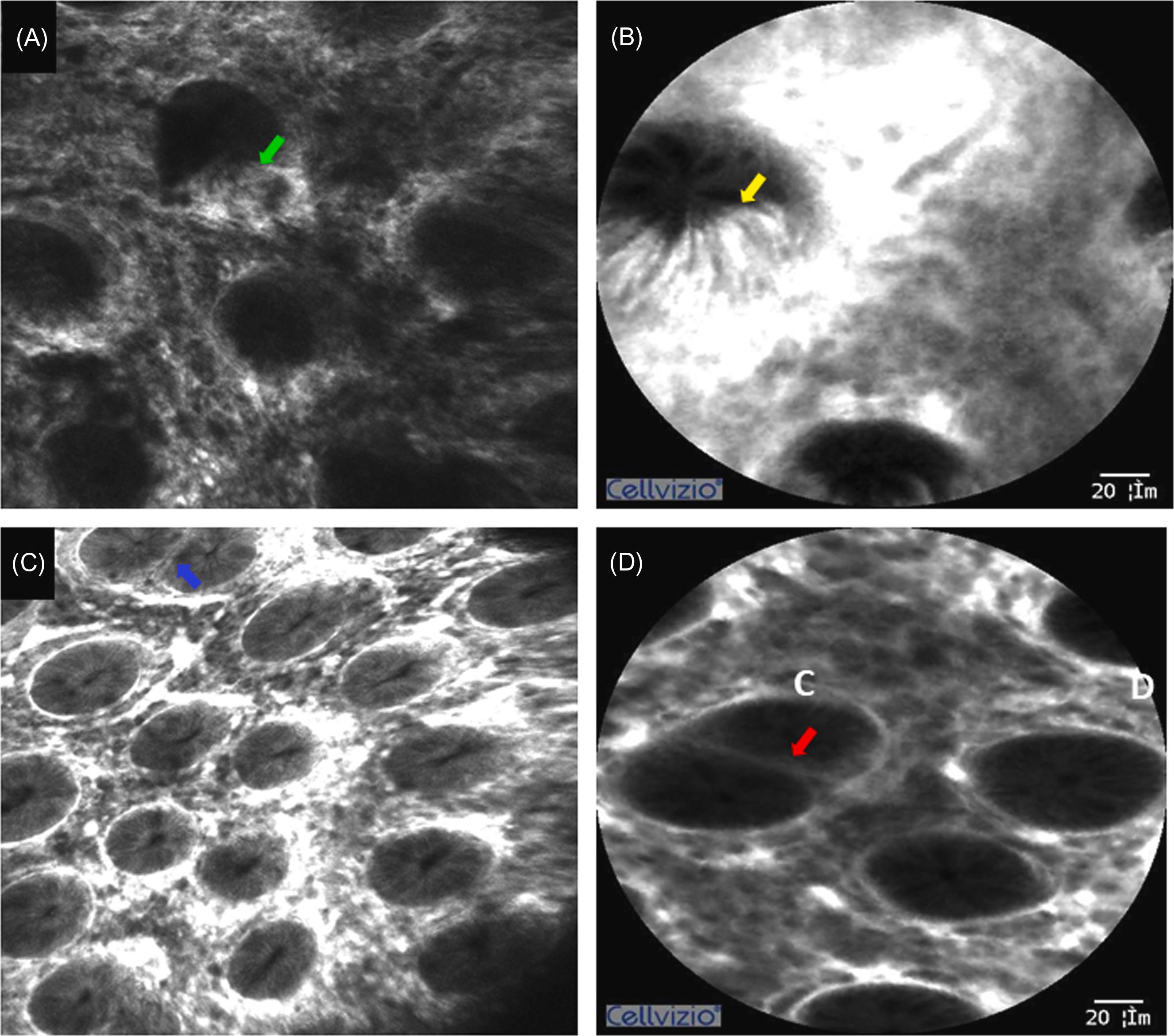
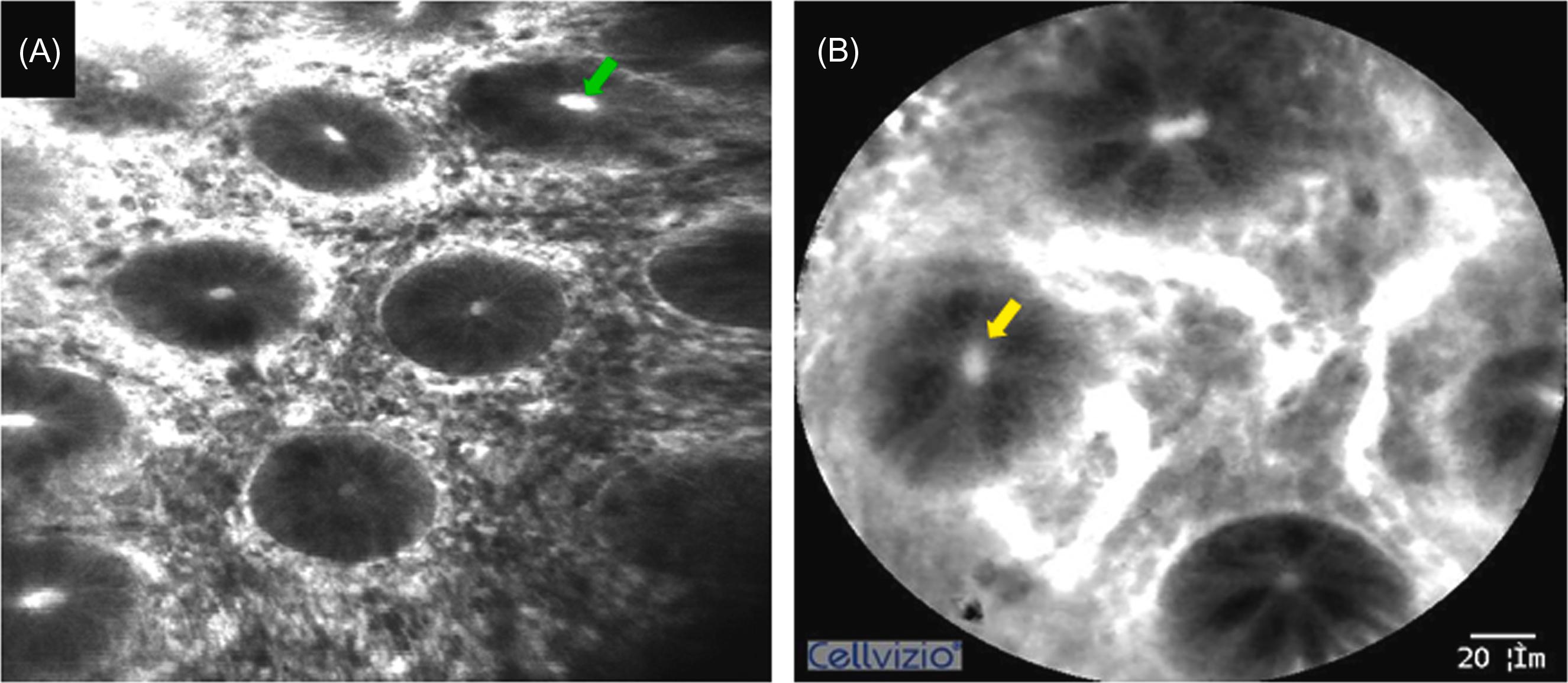
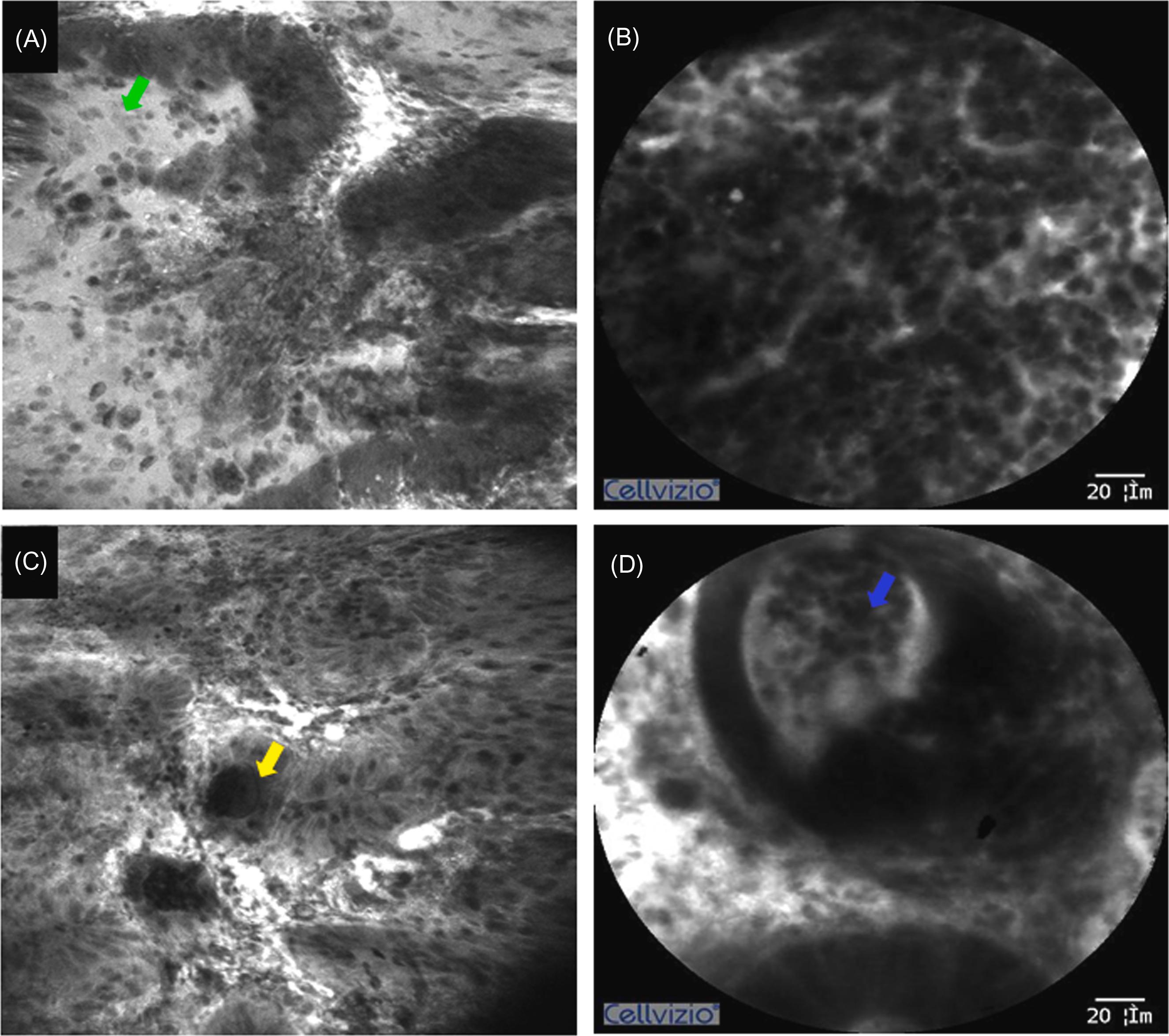
Become a Clinical Tree membership for Full access and enjoy Unlimited articles
If you are a member. Log in here